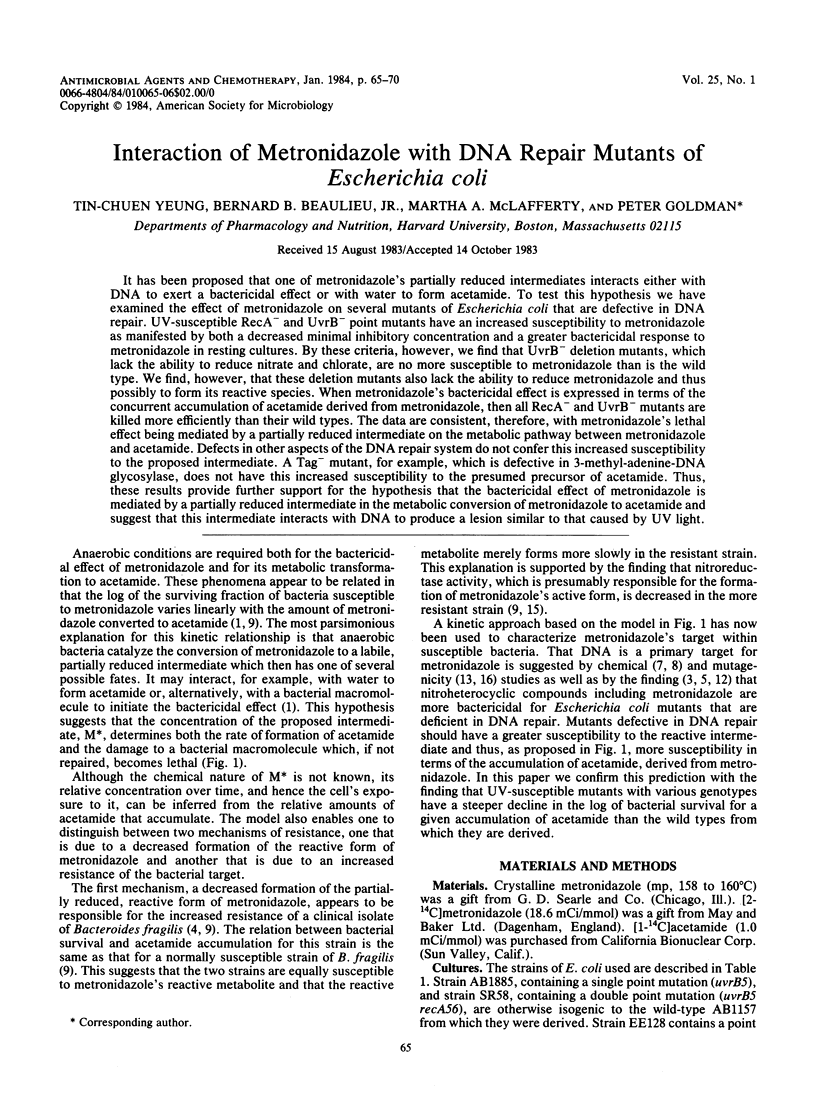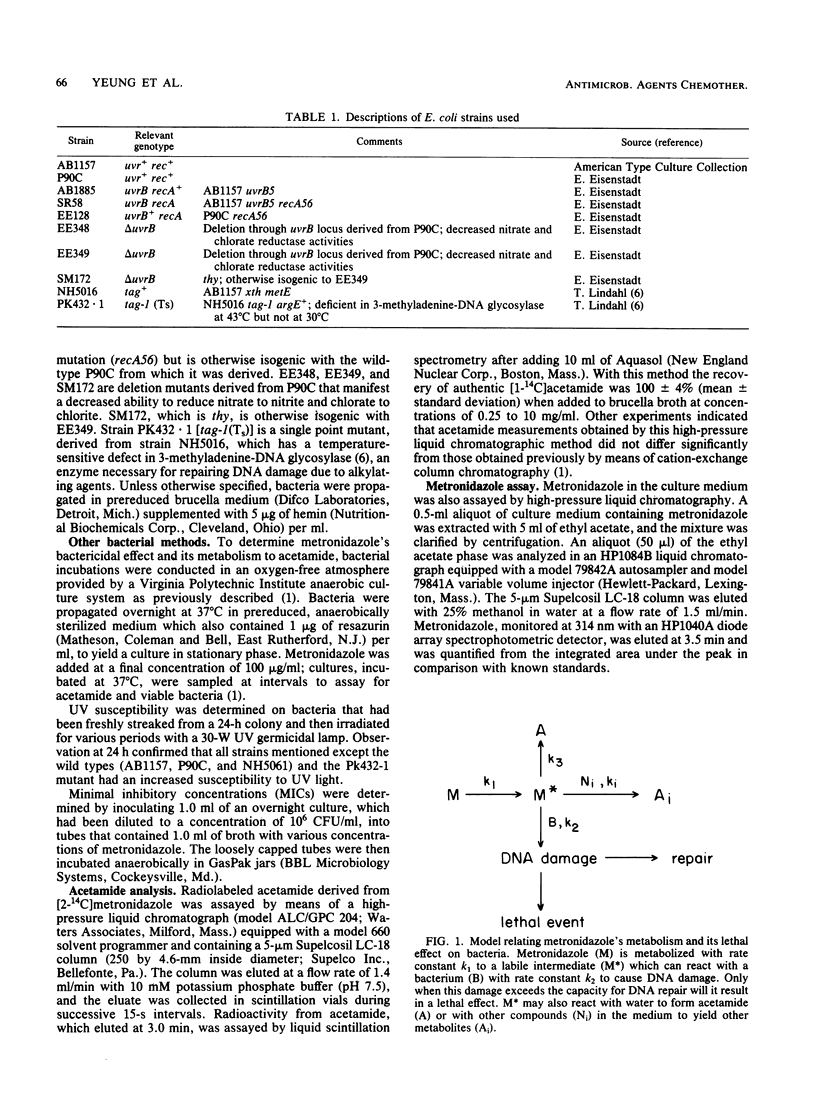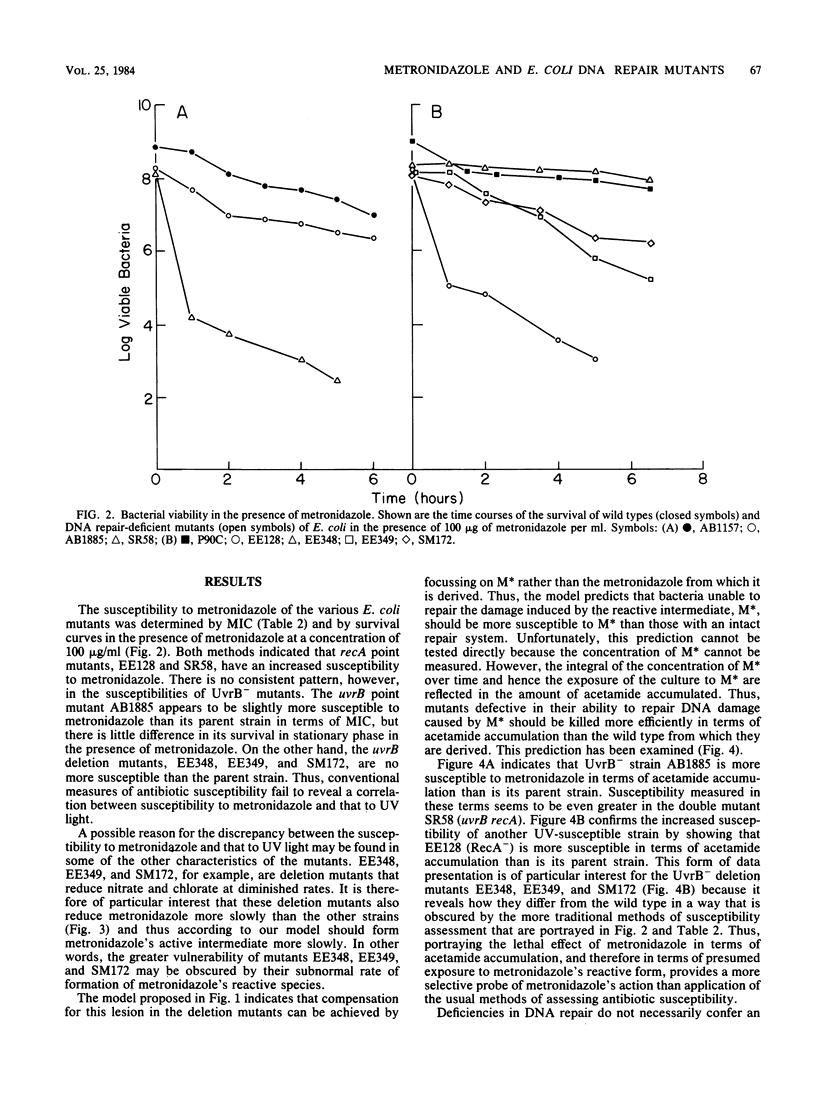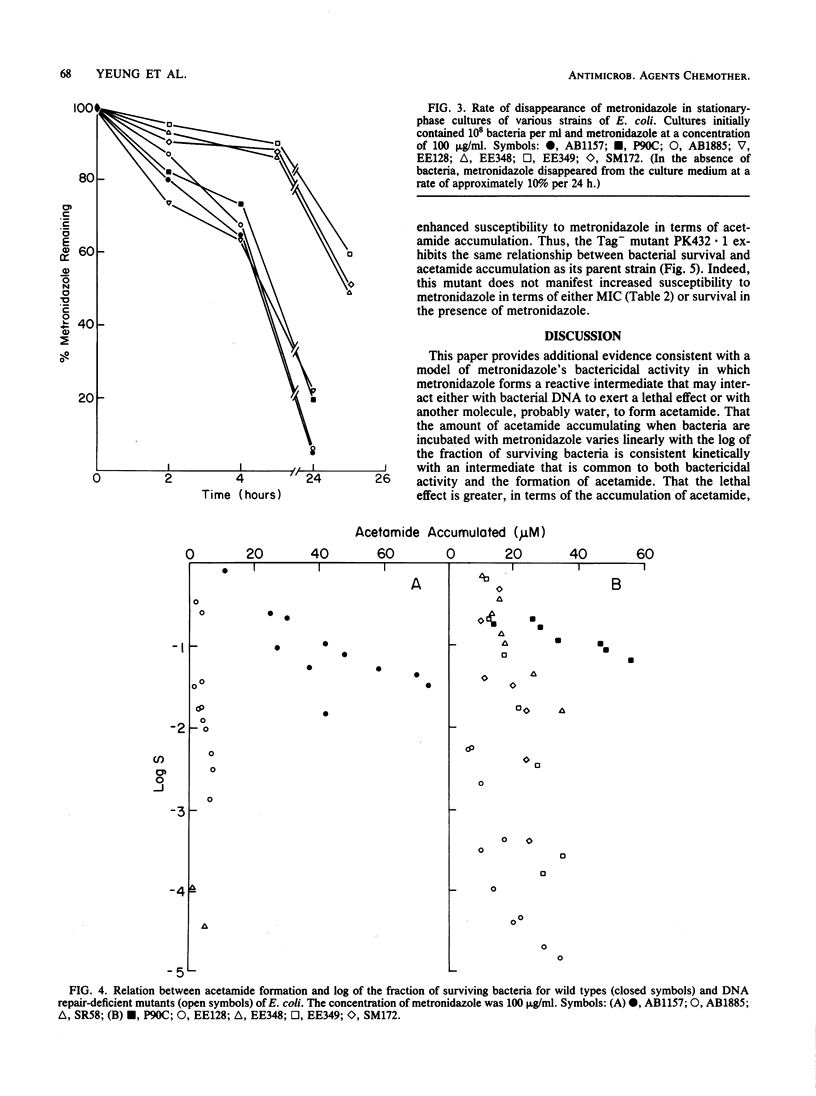Abstract
It has been proposed that one of metronidazole's partially reduced intermediates interacts either with DNA to exert a bactericidal effect or with water to form acetamide. To test this hypothesis we have examined the effect of metronidazole on several mutants of Escherichia coli that are defective in DNA repair. UV-susceptible RecA- and UvrB- point mutants have an increased susceptibility to metronidazole as manifested by both a decreased minimal inhibitory concentration and a greater bactericidal response to metronidazole in resting cultures. By these criteria, however, we find that UvrB- deletion mutants, which lack the ability to reduce nitrate and chlorate, are no more susceptible to metronidazole than is the wild type. We find, however, that these deletion mutants also lack the ability to reduce metronidazole and thus possibly to form its reactive species. When metronidazole's bactericidal effect is expressed in terms of the concurrent accumulation of acetamide derived from metronidazole, then all RecA- and UvrB- mutants are killed more efficiently than their wild types. The data are consistent, therefore, with metronidazole's lethal effect being mediated by a partially reduced intermediate on the metabolic pathway between metronidazole and acetamide. Defects in other aspects of the DNA repair system do not confer this increased susceptibility to the proposed intermediate. A Tag- mutant, for example, which is defective in 3-methyl-adenine-DNA glycosylase, does not have this increased susceptibility to the presumed precursor of acetamide. Thus, these results provide further support for the hypothesis that the bactericidal effect of metronidazole is mediated by a partially reduced intermediate in the metabolic conversion of metronidazole to acetamide and suggest that this intermediate interacts with DNA to produce a lesion similar to that caused by UV light.
Full text
PDF





Selected References
These references are in PubMed. This may not be the complete list of references from this article.
- Chrystal E. J., Koch R. L., McLafferty M. A., Goldman P. Relationship between metronidazole metabolism and bactericidal activity. Antimicrob Agents Chemother. 1980 Oct;18(4):566–573. doi: 10.1128/aac.18.4.566. [DOI] [PMC free article] [PubMed] [Google Scholar]
- Goldman P. The development of 5-nitroimidazoles for the treatment and prophylaxis of anaerobic bacterial infections. J Antimicrob Chemother. 1982 Aug;10 (Suppl A):23–33. doi: 10.1093/jac/10.suppl_a.23. [DOI] [PubMed] [Google Scholar]
- Goldstein B. P., Nielsen E., Berti M., Bolzoni G., Silvestri L. G. The mechanism of action of nitro-heterocyclic antimicrobial drugs. Primary target of 1-methyl-2-nitro-5-vinylimidazole is DNA. J Gen Microbiol. 1977 Jun;100(2):271–281. doi: 10.1099/00221287-100-2-271. [DOI] [PubMed] [Google Scholar]
- Ingham H. R., Eaton S., Venables C. W., Adams P. C. Bacteroides fragilis resistant to metronidazole after long-term therapy. Lancet. 1978 Jan 28;1(8057):214–214. doi: 10.1016/s0140-6736(78)90655-4. [DOI] [PubMed] [Google Scholar]
- Jenkins S. T., Bennett P. M. Effect of mutations in deoxyribonucleic acid repair pathways on the sensitivity of Escherichia coli K-12 strains to nitrofurantoin. J Bacteriol. 1976 Mar;125(3):1214–1216. doi: 10.1128/jb.125.3.1214-1216.1976. [DOI] [PMC free article] [PubMed] [Google Scholar]
- Karran P., Lindahl T., Ofsteng I., Evensen G. B., Seeberg E. Escherichia coli mutants deficient in 3-methyladenine-DNA glycosylase. J Mol Biol. 1980 Jun 15;140(1):101–127. doi: 10.1016/0022-2836(80)90358-7. [DOI] [PubMed] [Google Scholar]
- Knight R. C., Skolimowski I. M., Edwards D. I. The interaction of reduced metronidazole with DNA. Biochem Pharmacol. 1978;27(17):2089–2093. doi: 10.1016/0006-2952(78)90277-0. [DOI] [PubMed] [Google Scholar]
- LaRusso N. F., Tomasz M., Müller M., Lipman R. Interaction of metronidazole with nucleic acids in vitro. Mol Pharmacol. 1977 Sep;13(5):872–882. [PubMed] [Google Scholar]
- McLafferty M. A., Koch R. L., Goldman P. Interaction of metronidazole with resistant and susceptible Bacteroides fragilis. Antimicrob Agents Chemother. 1982 Jan;21(1):131–134. doi: 10.1128/aac.21.1.131. [DOI] [PMC free article] [PubMed] [Google Scholar]
- Müller M. Action of clinically utilized 5-nitroimidazoles on microorganisms. Scand J Infect Dis Suppl. 1981;26:31–41. [PubMed] [Google Scholar]
- Perez-Reyes E., Kalyanaraman B., Mason R. P. The reductive metabolism of metronidazole and ronidazole by aerobic liver microsomes. Mol Pharmacol. 1980 Mar;17(2):239–244. [PubMed] [Google Scholar]
- Rosenkranz H. S., Speck W. T. Mutagenicity of metronidazole: activation by mammalian liver microsomes. Biochem Biophys Res Commun. 1975 Sep 16;66(2):520–525. doi: 10.1016/0006-291x(75)90541-0. [DOI] [PubMed] [Google Scholar]
- Sullivan C. E., Tally F. P., Goldin B. R., Vouros P. Synthesis of 1-(2-hydroxyethyl)-2-methyl-5-aminoimidazole: a ring-intact reduction product of metronidazole. Biochem Pharmacol. 1982 Aug 15;31(16):2689–2691. doi: 10.1016/0006-2952(82)90722-5. [DOI] [PubMed] [Google Scholar]
- Voogd C. E., Van der Stel J. J., Jacobs J. J. The mutagenic action of nitroimidazoles. I. Metronidazole, nimorazole, dimetridazole and ronidazole. Mutat Res. 1974 Dec;26(6):483–490. doi: 10.1016/s0027-5107(74)80049-7. [DOI] [PubMed] [Google Scholar]


